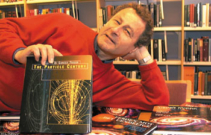Communicating the unfamiliar ideas of basic physics is already a challenge. With theories for the 21st century already on the drawing board and looking even more bizarre, CERN Courier editor Gordon Fraser wonders how to get the message across.

As we worry about how we will mark the passage of the millennium and whether its technology will survive that incremental year, fundamental physics has already embarked on its assault on the 21st century. Caught up in the jostle, it is hard to perceive this acceleration. But look back 100 years and it is clear how the prospect of the 20th century provided incentive right across the cultural spectrum.
The work of poverty-stricken artists who were humiliated by the drudgery of unrecognized creativity now trades for fortunes. Fresh influences that were to fire the popular music of the 20th century blazed only in the confines of the ghetto.
Physics too was poised on a launchpad. The decade spanning the 19th and 20th centuries brought a chain reaction of discovery: X-rays, radioactivity, the electron, quantum theory, special relativity…Before the century was much older, a full theory of relativity and the interpretation of empirical quantum theory in terms of quantum mechanics had revolutionized our understanding of the universe.
Rather than having been assimilated into the collective consciousness, these two monuments of human intellect quantum mechanics and relativity still remain obstacles to the public understanding of science. In his introduction to the first edition of his masterpiece The Principles of Quantum Mechanics, Paul Dirac said: “The methods of progress of theoretical physics have undergone a vast change during the present century [he wrote in 1930!]. The classical tradition has been to consider the world to be an association of observable objects (particles, fluids, etc) moving about according to definite laws of force, so that one could form a mental picture in space and time of the whole scheme…It has become increasingly evident…that nature works on a different plan. Her fundamental laws do not govern the world as it appears in our mental picture in any very direct way, but instead they control a substratum of which we cannot form a mental picture without introducing irrelevancies.”
Dirac was trying to encourage students who were about to embark on a difficult but rewarding book, warning them that they should loosen the straps on their 19th-century imagery of springs and gear-wheels and prepare to accept an unfamiliar “impressionist” physics.
Some 70 years later, many generations of physicists have learned to handle relativity and quantum mechanics in their sleep, but these concepts remain a foreign language for the uninitiated.
“The new theories, ” wrote Dirac, “if one looks apart from their mathematical setting, are built up from physical concepts which cannot be explained in terms of things previously known…which cannot even be explained adequately in words at all. Like the fundamental concepts which everyone must learn on their arrival into the world, the newer concepts of physics can be mastered only by long familiarity with their properties and uses.”
For the 21st century, physicists are venturing into even deeper conceptual water, painting ambitious new pictures that even Dirac would have shunned. Abandoning the “classical” concept of point particles in favour of two dimensional strings in many-dimensional spaces, new developments suggest that some of the mysteries of quarks and gluons could be inferred from quantum theories of gravity cast in many more dimensions than once was ever thought necessary. The microworld could be a hologram of an otherwise invisible structure of a larger universe.
Superstrings
Recent CERN Courier articles on superstrings by Gabriele Veneziano and Yaron Oz have pointed out how we could have been blindfolded by living in a four-dimensional spacetime lesion embedded in a much larger, but ironically indiscernible, scheme. Our limited experience might not be that of most of the rest of the universe, and another Copernican revolution might be round the corner.
These ambitious theories are not yet ready for any textbooks, but something will surely emerge from all of this intellectual industry. Such a reappraisal of our understanding could go on to parallel Planck’s introduction of the quantum concept 100 years ago.
If these new theories do bear fruit, then the problems underlined by Dirac 70 years ago will have been amplified. The preface to the ultimate 21st-century textbook The Principles of Superstrings will have to encourage students even more than Dirac did, and the public, blinkered by living in three dimensions, let alone four, could be even more in the dark and seek easier intellectual comfort.
The 21st-century public could find physics not to its taste unless a major effort goes into making the subject palatable. For physics, a key problem is to accomplish this while retaining the confidence and credibility of the scientists. Paraphrasing what can ultimately only be expressed with mathematical precision can attract heavy dogmatic firepower. Researchers accustomed to peer review frequently get hold of the wrong end of the stick when confronted with a popular market.
A successful play now running in London has shown that physics, given the right treatment, can have popular appeal. However, science communication ultimately has to come from scientists. Where Carl Sagan and Stephen Hawking whetted the public appetite for the incomprehensible, others have followed. With the prospect of fresh conceptual horizons, a new door is open.





